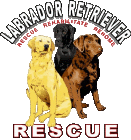The Labrador Retriever In Detail
The Labrador Retriever is a medium sized dog, weighing somewhere between 50 and 100 pounds, with females weighing in on the smaller side. Their height at the shoulders should be from 20-22 inches to about 24-26 inches. Some are large-boned, strongly built, square looking dogs, while others are lighter-boned, longer-bodied with a more athletic appearance.
A Labrador Retriever’s head can be somewhat long and narrow, with a light stop; or blocky and square with a well-defined stop; or anywhere in between. Their ears hang moderately close to the head, rather far back, and are set low. Their eyes are brown, yellow, or black.
The tail is what distinguishes the Labrador Retriever. It is very thick at the base, tapering to the tip, gently rounded, reaching about to the top of the hock. It is described as an “otter tail.” However, many AKC Labrador Retrievers have a long narrow tail which may be set high or low, may be carried straight off the back or slightly curled.
Coat colors vary from yellow (pale cream to a much darker yellow/fox red), chocolate, and black. White hairs may appear as a spot or blaze on the chest, on the muzzle (older dogs), or on the feet. Other than that, they are a solid-colored dog. Labs have a double coat, but sometimes the undercoat is slight or missing. Their coat is hard, close, short, straight, and dense without feathering. Sometimes there is a slight wave to the coat along the back.
Labrador Retrievers require very little grooming but love a good brushing daily. They shed their coats twice a year. Flea control is important, as they may have allergic reactions to fleas. Labs in good health do not smell. Frequent bathing can result in a variety of problems since it removes the natural oils from their coat. Their ears need to be kept clean and toenails should be cut regularly.
Labradors are used extensively as assistance and therapy dogs—working with the physically disabled, guiding the blind, pulling wheelchairs, and visiting convalescent centers; for detecting drugs, arson, and bombs; and as hunting companions and family pets. They will bark an alarm at home but are NOT guard or attack dogs. Labrador Retrievers are happy-go-lucky, active, and friendly dogs.
They will play with children and make great family pets, as their temperament should not be hyper, shy, aggressive, or quarrelsome. Most labs get along well with other dogs provided they are introduced properly. The Labrador has a constantly wagging tail, a great joy of life, is anxious to please, enthusiastic, agreeable, and eager to participate in any venture or duty offered. They are retrievers and love to retrieve anything (house slippers, tennis ball, sticks).
Labrador Retrievers may be an active puppy until 5 or 6 years of age and tend to enjoy chewing. Labs should be given some basic training to direct their energies properly. A class in obedience (sit, heel, down, stay, come) is ideal, as is crate training. Most labs are highly food motivated, so training usually can be accomplished without the need for harsh corrections. They are very clean and easily housebroken.
Labs can live happily in an apartment or on a big ranch as long as they get daily exercise and loving companionship. Labs are very people oriented and are happiest when with their human families. They do not adapt well to being outside-only dogs. When left alone for long periods of time outside, they tend to develop unacceptable behaviors such as barking, digging, and destructive chewing. Labs must have a secure/fenced area as they often roam and would rather go visiting than stay at home. They love to eat everything–and do. Caution should be taken to ensure that they do not get overweight.
Common health problems of Labradors are hip/elbow/hock/shoulder dysplasia (detected by x-ray). They also may suffer from ophthalmological defects (including cataracts, eyelid deformities, progressive retinal atrophy, and retinal dysplasia), seizures, and skin allergies.
Their life span can be anywhere from 10 to 14 years of age on up to 16 or 17. As the older dog may suffer from joint aches and pains, anti-inflammatory medication under the direction of a veterinarian may be helpful, especially in cold weather. Labs can live indoors or outdoors as long as they are warm and dry, but the older dog benefits from a warm, indoor bed at night. A lab should be part of the family group and allowed indoors as a matter of routine.
Reprinted from the Project BREED Directory Series. Contact Project BREED, Inc., PO Box 15888, Chevy Chase, MD 20825-5888 for information on obtaining directories.





